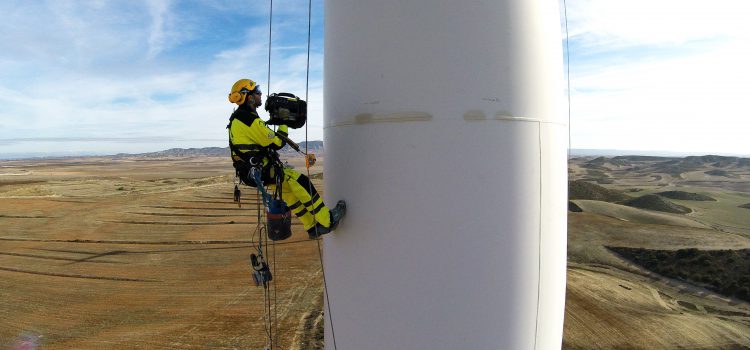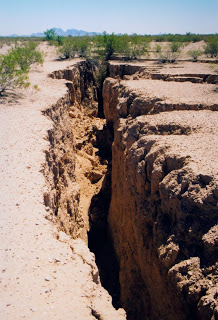Swinging from a Wind Turbine in an Earthquake
On September 19, 2017, a 7.1 magnitude earthquake struck the central region of Mexico. Blade technician Ewa Pilch and engineer Narciso Lozano happened to be uptower during the 20 seconds the ground heaved beneath them. The company in charge of maintaining the Oaxacan region wind farm was immediately alerted, and scrambled to make sure their workers were safe.

A deadly earthquake measuring 8.2 on the Richter scale had affected Mexico's southern coastal area twelve days earlier, followed by numerous aftershocks. Nonetheless, we did not anticipate any major obstacles to completing the assignment. We arrived on location a couple of days before starting work, and were staying in a local town, when we found ourselves near the earthquake's epicenter. The power of the tremor inflicted severe damage; in a region of nearly 3,000 wind turbines, it disabled a key power transformer. Wind energy production across the region came to a screeching halt.
A safe foundation
Even in the best conditions, ascending a wind tower to do your job while dangling over 200 feet above the ground is not for the faint of heart. The higher you go, the more you feel the movement around you. There were numerous aftershocks in the week following our arrival. With no guarantee of being able to safely complete the work, we were unable to conduct any inspections on the turbines, and were told to stand down.
Before we could finally begin inspections, checks were conducted on the tower foundations for all turbines at the site, to ensure they were both safe to operate, and safe to ascend. Even after the site was deemed safe for working, there was an additional obstacle to overcome - lack of power. With the transformer offline, and generators in high demand for humanitarian needs, we ultimately had to source an adequate generator from a neighboring state. The back-up generator provided enough power to work the tower lift, but not enough to help yaw the turbine, or pitch the blade.
 A moving tower
A moving tower
Tuesday, September 19th,brought wind speeds between 15 and 17 m/s. Despite such strong winds at the site (and already hindered by the extra delay) we, and the client, were anxious to begin up-tower operations. While I stood on the nacelle, Ewa descended on a rope to inspect the first of the turbine blades.
The strong winds were heavily swaying the tower when the 7.1 earthquake hit; on the nacelle no immediate change in the movement of the turbine tower was noticeable. Down on the ropes however, Ewa knew something was wrong: the rocking effect of the earthquake was noticeably different to the effects of the wind.
As soon as the substation team confirmed the tremor, we immediately descended from the turbine. Ewa was able to lower herself down to the ground, but from the nacelle, we had to climb down the tower using the ladder, in case the earthquake had caused damage to the lift. Given the scale of the earthquake, the day's remaining operations were cancelled.
A final call
Following the completion of additional safety checks on the foundations, it was deemed safe to return to the site. However, with no power to the turbines and the blades feathered into the wind to protect them, we had to wait for the wind to blow in the right direction in order to spin the rotor, so we could lock the rotor in the right position and inspect the blade. Half a day's worth of inspections ended up taking two weeks. Additionally, due to the challenges of orienting the blades, inspections could only be completed on a single turbine.
It was hoped power could be restored to the wind farm so we could more easily move the blades into position and complete the work. However, when the town was hit by yet another earthquake, we were forced to abandon the area, including our hotel.
As the low-wind season approaches in Mexico, we'll be back to complete the inspections - hopefully under less turbulent conditions.
Narciso Lozano is a rotor blade engineer at Altitec, where he analyzes blade inspection and damage reports, and advises clients on repair and maintenance programs for blade composites. Altitecisanindependentlyoperated, specialistropeaccessbladeinspectionandrepairbusiness, headquarteredinLondonand Berlin. Since2010, Altitectechnicianshaveprovidedregularinspectionsonmorethan5,000 bladesand1,500 turbinesthroughouttheUK, Europeandkeyemergingwindmarketsaroundtheworld. Altitec providesafullrangeofbladeinspection, repairandmaintenanceservices, aswellasanestablished, industrycertifiedtrainingprogram, theAltitecAcademy. AltitecholdsdistributionrightsfortheActsafeAscenderintheUK, Baltics, andIreland.
Altitec| www.altitec.co.uk
Volume: 2018 May/June









